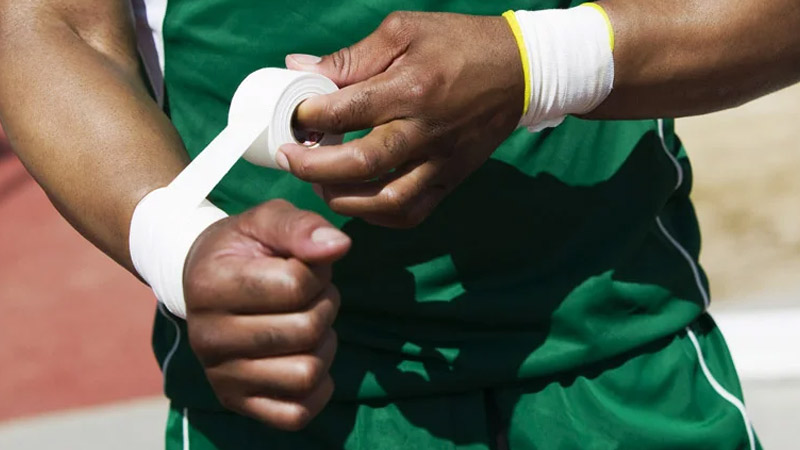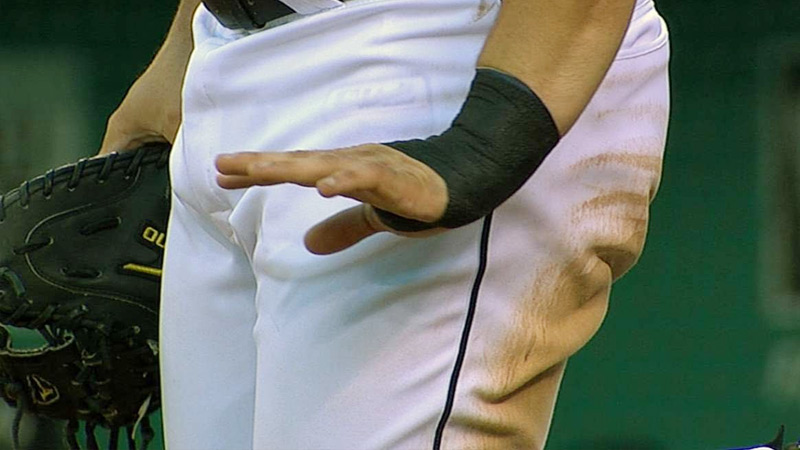Baseball is a game of skill, strategy, and athleticism, demanding peak performance from its players.
In the pursuit of excellence, baseball players often turn to various tools and accessories to enhance their performance and protect against potential injuries. One such accessory commonly seen in the world of baseball is wrist tape.
In this article, we will delve into the purpose and benefits of wrist tape in baseball and explore the different types used by players. Stay focused.
What Is Wrist Tape?
Wrist tape, also known as athletic tape, is a flexible adhesive tape specifically designed for sports-related applications.
It is made of cotton or synthetic fabric and features an adhesive backing to provide stability and support to the wrist joint.
Wrist tape is highly customizable, allowing players to wrap it tightly or loosely around their wrists based on their specific needs.
Types of Wrist Tapes Baseball Players Use
The types of wrist tapes used by baseball players are mentioned in the following section. Check them out below.
Rigid Wrist Tape
Rigid wrist tape is a type of tape that provides maximum support and stability to the wrist joint. It is commonly used by players who are recovering from wrist injuries or seeking additional reinforcement during high-intensity activities.
The tape is generally less elastic and offers a rigid structure that limits excessive movement of the wrist. This type of tape is ideal for players who require significant support to prevent further injury or to protect a weak or vulnerable wrist.
Elastic Wrist Tape
Elastic wrist tape strikes a balance between support and flexibility. It offers a moderate level of stability while allowing for a greater range of motion in the wrist joint. Elastic tape is commonly used by players who require mobility and flexibility during gameplay.
It provides enough support to prevent excessive movement that could lead to injuries, while still allowing the wrist to move naturally. This type of tape is often favored by players who need to maintain agility and dexterity, such as infielders or outfielders.
Kinesiology Tape
Kinesiology tape, also known as “k-tape,” is a stretchy and adhesive tape that closely mimics the elasticity of human skin. It is designed to facilitate movement while providing support and therapeutic benefits.
Kinesiology tape is used to alleviate pain, improve circulation, and enhance proprioception (awareness of body position and movement). It is commonly utilized for injury prevention and rehabilitation.
When applied to the wrist, kinesiology tape can help support the joint, reduce pain, and promote a sense of stability without restricting movement. This type of tape is often preferred by players dealing with chronic wrist issues or those seeking a balance between support and flexibility.
Whether it’s maximizing stability, maintaining flexibility, or addressing pain and discomfort, wrist tape can be tailored to provide the necessary support and functionality to enhance performance and protect against injuries on the baseball field.
Why Do Baseball Players Tape Their Wrists?

Source: sterosport.co.uk
Some of the common reasons for using wrist tapes are pointed out in the following part. Have a close look at them below.
Helps Heal Prior Injury Faster
Wrist tape can aid in the recovery process by providing compression, support, and stability to a previously injured wrist. When a player sustains a wrist injury, such as a sprain or strain, the joint becomes inflamed and can be susceptible to further damage.
By applying wrist tape, the injured area is compressed, which helps reduce swelling and inflammation.
Additionally, the tape provides support to the joint, limiting excessive movement and allowing the injured tissues to heal more efficiently. This can expedite the recovery process and enable players to return to the field sooner.
Helps Avoid Injuries
Baseball involves repetitive motions that put significant strain on the wrists. The throwing, catching, and swinging actions can create stress and instability in the joint, making it susceptible to injuries such as sprains, strains, or even fractures.
Wrist tape helps minimize the risk of such injuries by providing additional support and stability.
It acts as a protective layer around the joint, absorbing some of the forces generated during gameplay and reducing the strain on the wrist. This can help prevent acute injuries and mitigate the chances of chronic wrist issues.
Covering Up Jewelry
Baseball players are required to remove all jewelry, including bracelets, watches, and rings, before participating in games. This rule is primarily for safety reasons, as loose or sharp objects can pose a risk to both the player wearing them and others on the field.
Wrist tape offers a practical solution for players who wish to cover up their jewelry. By wrapping their wrists with tape, they can ensure compliance with the rules while keeping their accessories concealed and secure.
Covering Up Tattoos
Some baseball players may have tattoos on their wrists that they prefer to hide during games. This could be due to personal preferences, team guidelines, or sponsor agreements.
Wrist tape provides a convenient way to cover up wrist tattoos, allowing players to maintain a uniform and professional appearance on the field.
The tape acts as a temporary concealment method, ensuring that the tattoos are not visible during gameplay or televised events.
Superstitions
Baseball players are notorious for their superstitions and rituals. Some athletes believe that certain actions or accessories bring them luck or enhance their performance.
Wrist tape has become a common element in the superstitious practices of many players.
Some may tape their wrists in a specific pattern or follow a routine before each game, associating it with positive outcomes or improved focus.
While the scientific basis for these beliefs may be questionable, the psychological impact and confidence boost derived from such rituals can positively influence a player’s mindset and overall performance.
Used for Professional Aesthetics
Wrist tape has evolved beyond its functional benefits and has become a symbol of dedication, toughness, and professionalism in the world of baseball.
The visible presence of wrist tape on a player’s wrists often signifies their commitment to the game and their readiness to perform at their best.
It has become an iconic part of the baseball aesthetic, with many fans and aspiring players emulating the practice.
Wearing wrist tape can enhance the perception of a player’s skill and determination, both on and off the field, creating a distinct image that resonates with the sport’s culture.
By recognizing these reasons and benefits, baseball players can make informed decisions regarding the use of wrist tape and leverage its advantages to optimize their performance and well-being.
How to Use Wrist Tape?
The step-by-step process of using wrist tape is discussed in the section below.
Clean and dry the skin
Before applying wrist tape, it is crucial to ensure that the skin is clean and dry. Any residue from lotions, oils, or sweat can affect the adhesion of the tape and lead to discomfort or irritation.
Gently clean the area with mild soap and water, then pat it dry thoroughly before proceeding.
Measure and cut the tape
Once the skin is prepared, determine the desired length of the tape. Start by measuring the circumference of the wrist, allowing for enough tape to provide adequate coverage.
Cut the tape using scissors or tear it along the pre-cut perforations if available. Make sure the cut is clean and even to facilitate smooth wrapping.
Start at the base of the palm
Begin the taping process by placing the starting end of the tape at the base of the palm, just above the wrist crease. Position it so that the tape will wrap around the wrist in the desired direction.
Ensure that the tape is applied with enough tension to provide support but not so tight that it restricts blood flow or causes discomfort.
Wrap diagonally
With the starting point secure, start wrapping the tape diagonally across the back of the hand, crossing over the back of the wrist, and moving towards the thumb side.
Maintain a 50% overlap with each wrap to ensure optimal support and stability. The diagonal wrapping pattern helps to stabilize the wrist joint by providing support from various angles.
Continue wrapping and adjust the tension
Continue wrapping the tape around the wrist, maintaining the diagonal pattern and overlap. As you wrap, periodically assess the tension to ensure it remains consistent.
The tape should be snug enough to provide support and stability without being overly tight. Adjust the tension as needed, taking into account personal comfort and the desired level of support.
Secure the end
Once you have achieved the desired coverage and support, secure the end of the tape. Press it firmly against the skin to ensure it adheres well. Alternatively, you can use a tape adherent spray or underwrap to enhance the tape’s adhesion.
These products can help keep the tape in place during intense physical activity or in situations where the tape may be exposed to sweat or moisture.
By following these step-by-step instructions, baseball players can effectively apply wrist tape to provide the desired support, stability, and protection to their wrists during games or practices.
FAQs
Can wrist tape improve my wrist strength?
Wrist tape primarily provides support and stability rather than directly improving wrist strength. However, by reducing the risk of injuries, it indirectly allows players to focus on strength-building exercises and skill development.
How long can I wear wrist tape?
The duration of wearing wrist tape depends on personal preference and the player’s needs. It is recommended to remove the tape after each game or practice session to allow the skin to breathe and prevent skin irritation.
Can I reuse wrist tape?
Wrist tape is not designed for multiple uses. The adhesive properties diminish with each application, making it less effective over time. It is advisable to use fresh tape for optimal support and adhesion.
Should I consult a professional for taping techniques?
While basic taping techniques can be learned and performed individually, it is recommended to consult a sports therapist, athletic trainer, or healthcare professional for more advanced taping methods and to address specific concerns or injuries.
Is wrist tape allowed in all baseball leagues?
The use of wrist tape is generally permitted in baseball leagues. However, it is advisable to check the specific rules and regulations of the league or organization in which you are participating to ensure compliance.
Bottom Line
Wrist tape serves a multifaceted role in the world of baseball. It provides support, stability, and protection to the wrists, helping players avoid injuries, heal faster, and maintain a professional appearance.
With its various types and customizable features, wrist tape has become an essential accessory for baseball players across all levels.
By understanding its benefits and proper usage techniques, players can make informed decisions about incorporating wrist tape into their training routines and on-field performances, enhancing their overall game experience. God bless you.







